Human Resource Management Assignment II: KSA 2018 Analysis Report
VerifiedAdded on 2021/06/14
|38
|11369
|47
Report
AI Summary
This report presents an analysis of two human resource management (HRM) situations. The first situation examines the application of relationship management competency in negotiating a contract with an HR software vendor, emphasizing conflict resolution strategies, the role of the HR director, and the importance of building relationships with vendors. The second situation focuses on communication competency, specifically how an HR department communicates a policy regarding education reimbursement to a diverse workforce, highlighting the advantages of team-based communication, various communication technologies, and the significance of feedback. The report delves into different aspects of HRM including relationship management, communication strategies, conflict resolution, and the role of an HR director in fostering positive workplace relationships and effective communication practices.
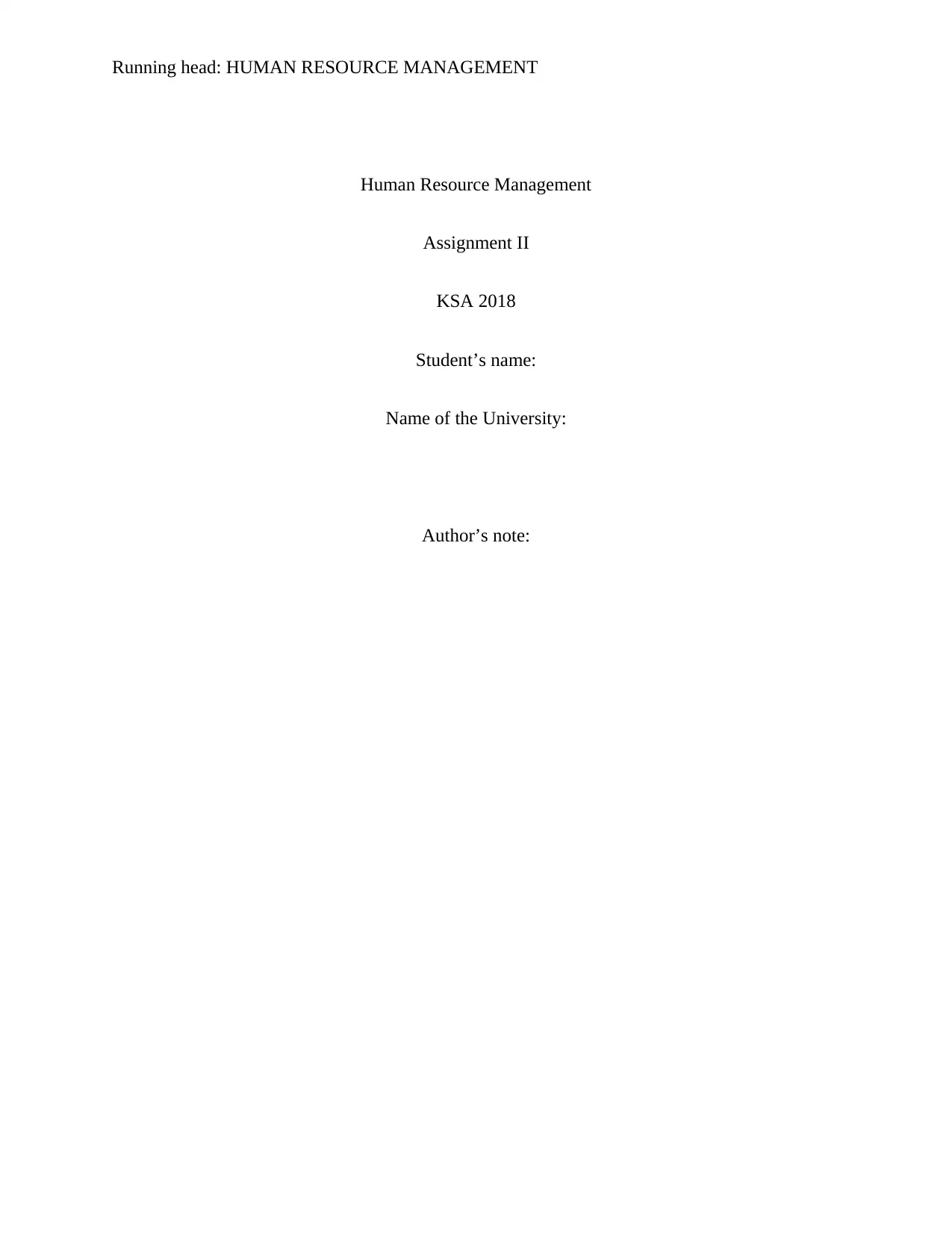
Running head: HUMAN RESOURCE MANAGEMENT
Human Resource Management
Assignment II
KSA 2018
Student’s name:
Name of the University:
Author’s note:
Human Resource Management
Assignment II
KSA 2018
Student’s name:
Name of the University:
Author’s note:
Paraphrase This Document
Need a fresh take? Get an instant paraphrase of this document with our AI Paraphraser
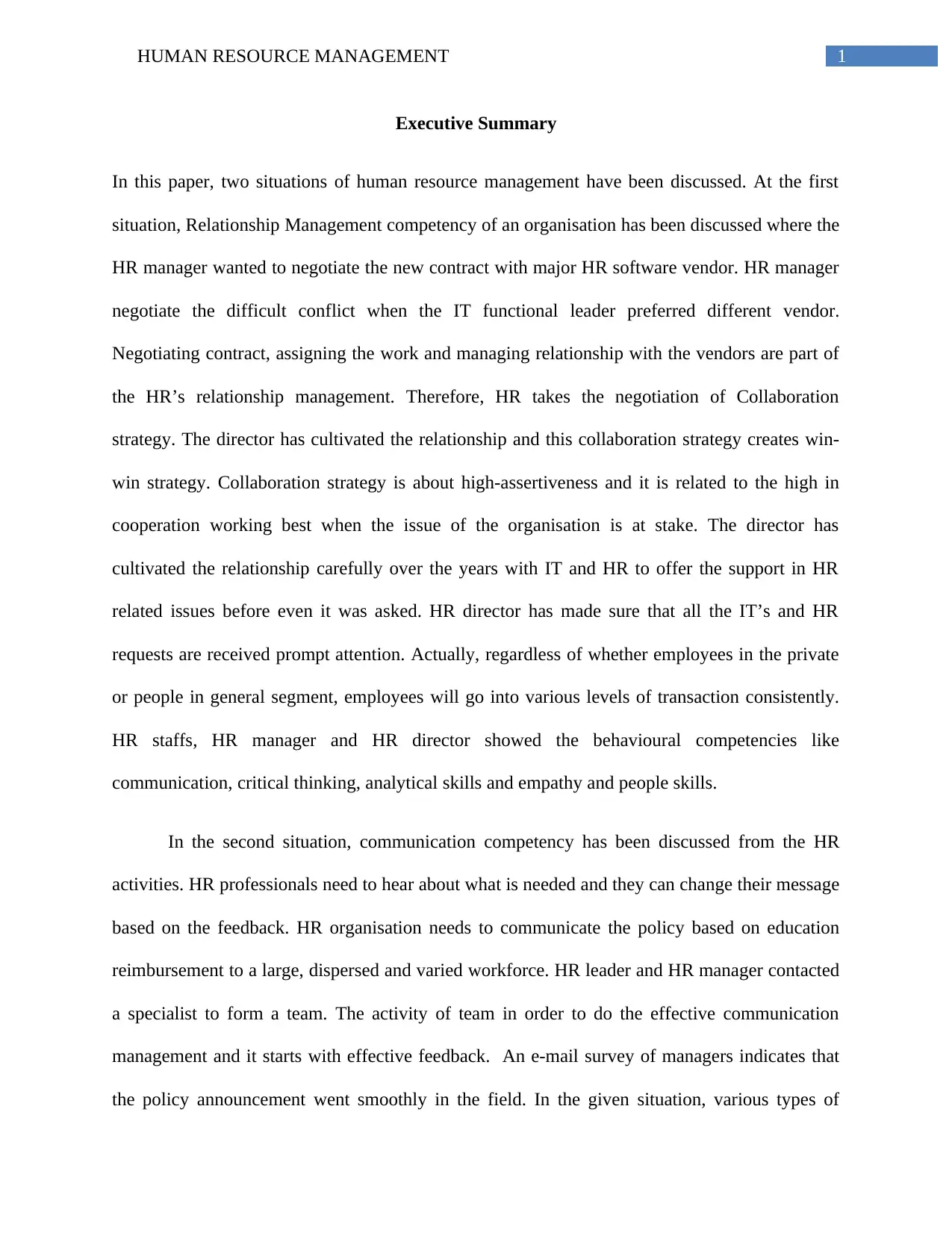
1HUMAN RESOURCE MANAGEMENT
Executive Summary
In this paper, two situations of human resource management have been discussed. At the first
situation, Relationship Management competency of an organisation has been discussed where the
HR manager wanted to negotiate the new contract with major HR software vendor. HR manager
negotiate the difficult conflict when the IT functional leader preferred different vendor.
Negotiating contract, assigning the work and managing relationship with the vendors are part of
the HR’s relationship management. Therefore, HR takes the negotiation of Collaboration
strategy. The director has cultivated the relationship and this collaboration strategy creates win-
win strategy. Collaboration strategy is about high-assertiveness and it is related to the high in
cooperation working best when the issue of the organisation is at stake. The director has
cultivated the relationship carefully over the years with IT and HR to offer the support in HR
related issues before even it was asked. HR director has made sure that all the IT’s and HR
requests are received prompt attention. Actually, regardless of whether employees in the private
or people in general segment, employees will go into various levels of transaction consistently.
HR staffs, HR manager and HR director showed the behavioural competencies like
communication, critical thinking, analytical skills and empathy and people skills.
In the second situation, communication competency has been discussed from the HR
activities. HR professionals need to hear about what is needed and they can change their message
based on the feedback. HR organisation needs to communicate the policy based on education
reimbursement to a large, dispersed and varied workforce. HR leader and HR manager contacted
a specialist to form a team. The activity of team in order to do the effective communication
management and it starts with effective feedback. An e-mail survey of managers indicates that
the policy announcement went smoothly in the field. In the given situation, various types of
Executive Summary
In this paper, two situations of human resource management have been discussed. At the first
situation, Relationship Management competency of an organisation has been discussed where the
HR manager wanted to negotiate the new contract with major HR software vendor. HR manager
negotiate the difficult conflict when the IT functional leader preferred different vendor.
Negotiating contract, assigning the work and managing relationship with the vendors are part of
the HR’s relationship management. Therefore, HR takes the negotiation of Collaboration
strategy. The director has cultivated the relationship and this collaboration strategy creates win-
win strategy. Collaboration strategy is about high-assertiveness and it is related to the high in
cooperation working best when the issue of the organisation is at stake. The director has
cultivated the relationship carefully over the years with IT and HR to offer the support in HR
related issues before even it was asked. HR director has made sure that all the IT’s and HR
requests are received prompt attention. Actually, regardless of whether employees in the private
or people in general segment, employees will go into various levels of transaction consistently.
HR staffs, HR manager and HR director showed the behavioural competencies like
communication, critical thinking, analytical skills and empathy and people skills.
In the second situation, communication competency has been discussed from the HR
activities. HR professionals need to hear about what is needed and they can change their message
based on the feedback. HR organisation needs to communicate the policy based on education
reimbursement to a large, dispersed and varied workforce. HR leader and HR manager contacted
a specialist to form a team. The activity of team in order to do the effective communication
management and it starts with effective feedback. An e-mail survey of managers indicates that
the policy announcement went smoothly in the field. In the given situation, various types of
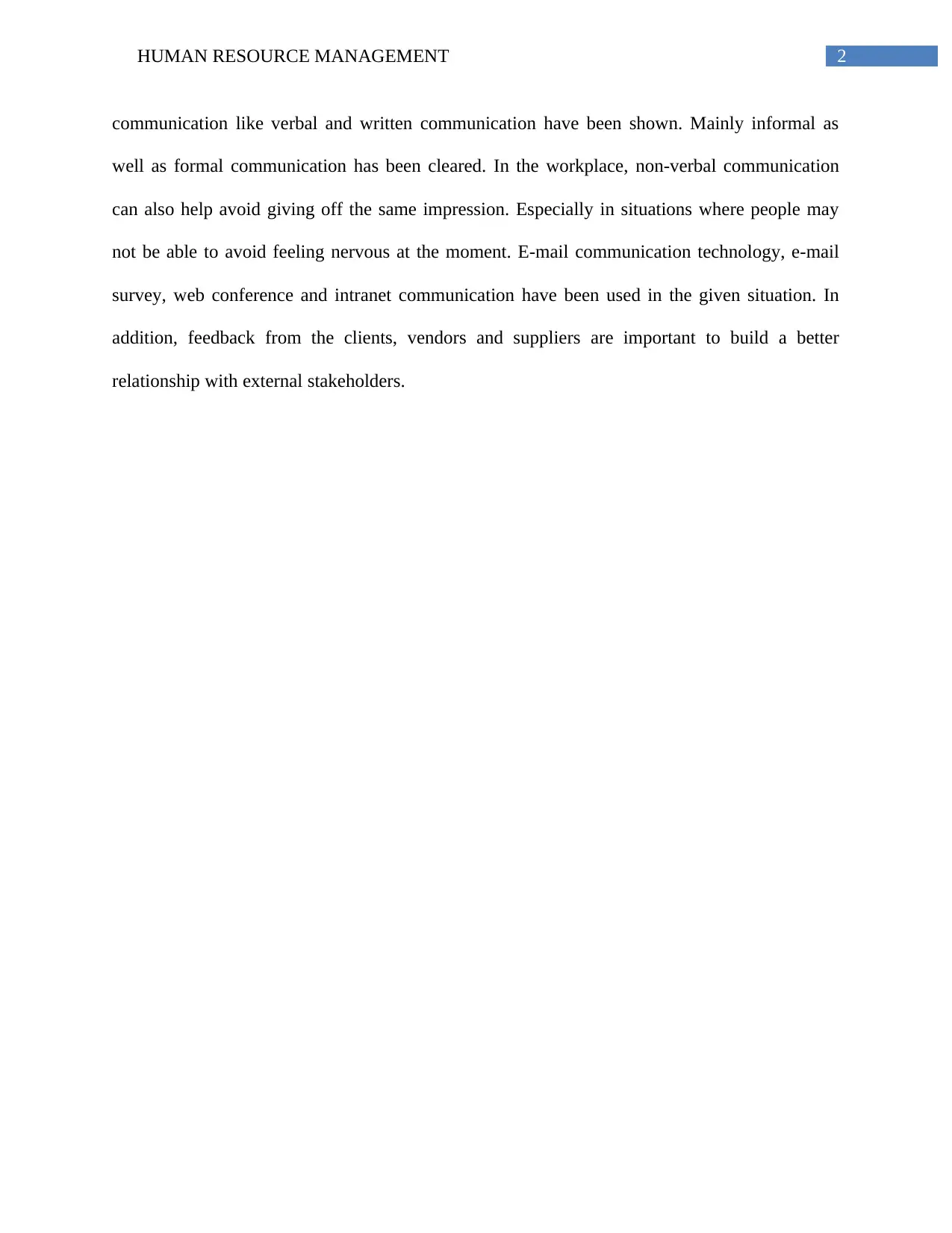
2HUMAN RESOURCE MANAGEMENT
communication like verbal and written communication have been shown. Mainly informal as
well as formal communication has been cleared. In the workplace, non-verbal communication
can also help avoid giving off the same impression. Especially in situations where people may
not be able to avoid feeling nervous at the moment. E-mail communication technology, e-mail
survey, web conference and intranet communication have been used in the given situation. In
addition, feedback from the clients, vendors and suppliers are important to build a better
relationship with external stakeholders.
communication like verbal and written communication have been shown. Mainly informal as
well as formal communication has been cleared. In the workplace, non-verbal communication
can also help avoid giving off the same impression. Especially in situations where people may
not be able to avoid feeling nervous at the moment. E-mail communication technology, e-mail
survey, web conference and intranet communication have been used in the given situation. In
addition, feedback from the clients, vendors and suppliers are important to build a better
relationship with external stakeholders.
⊘ This is a preview!⊘
Do you want full access?
Subscribe today to unlock all pages.

Trusted by 1+ million students worldwide
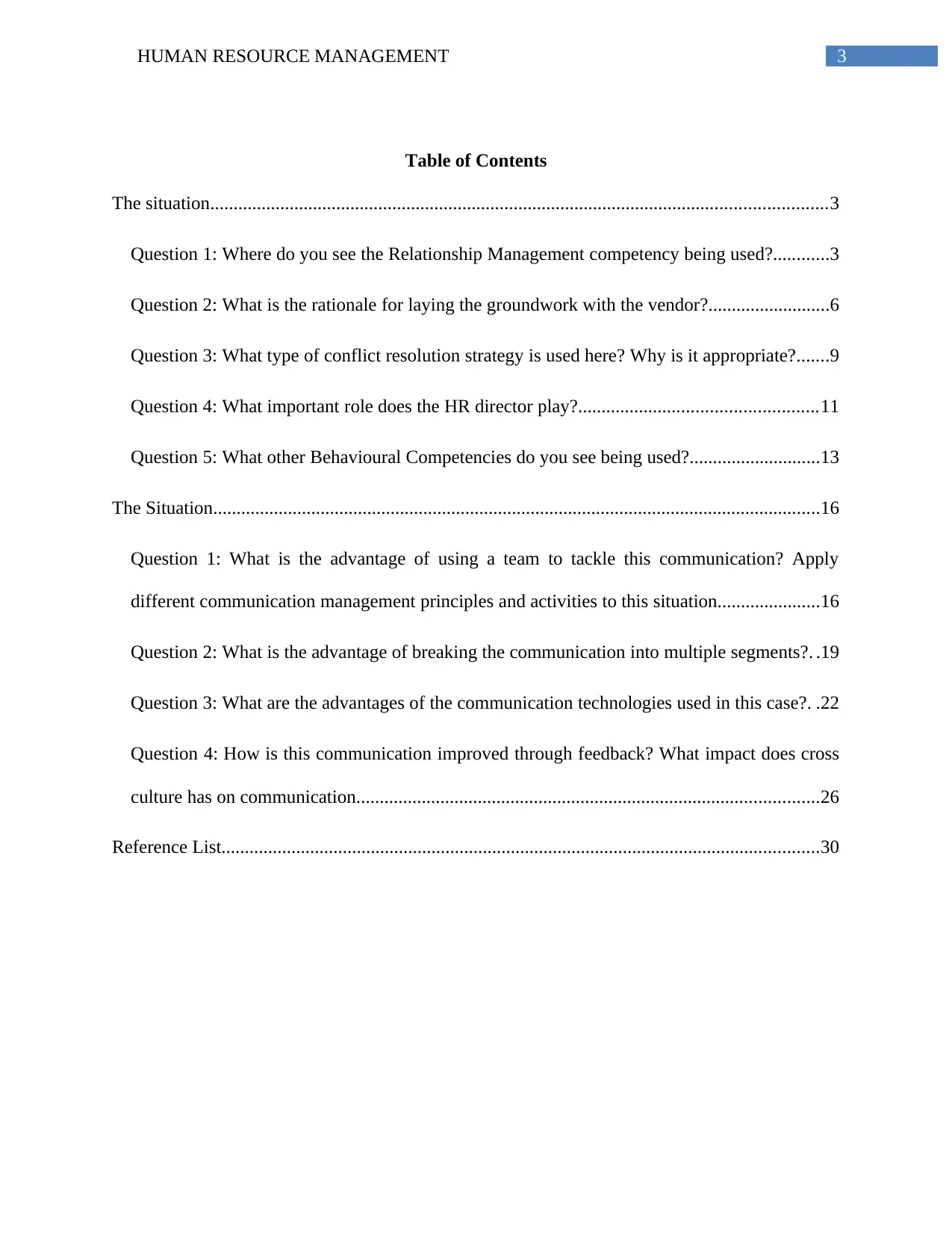
3HUMAN RESOURCE MANAGEMENT
Table of Contents
The situation....................................................................................................................................3
Question 1: Where do you see the Relationship Management competency being used?............3
Question 2: What is the rationale for laying the groundwork with the vendor?..........................6
Question 3: What type of conflict resolution strategy is used here? Why is it appropriate?.......9
Question 4: What important role does the HR director play?...................................................11
Question 5: What other Behavioural Competencies do you see being used?............................13
The Situation..................................................................................................................................16
Question 1: What is the advantage of using a team to tackle this communication? Apply
different communication management principles and activities to this situation......................16
Question 2: What is the advantage of breaking the communication into multiple segments?. .19
Question 3: What are the advantages of the communication technologies used in this case?. .22
Question 4: How is this communication improved through feedback? What impact does cross
culture has on communication...................................................................................................26
Reference List................................................................................................................................30
Table of Contents
The situation....................................................................................................................................3
Question 1: Where do you see the Relationship Management competency being used?............3
Question 2: What is the rationale for laying the groundwork with the vendor?..........................6
Question 3: What type of conflict resolution strategy is used here? Why is it appropriate?.......9
Question 4: What important role does the HR director play?...................................................11
Question 5: What other Behavioural Competencies do you see being used?............................13
The Situation..................................................................................................................................16
Question 1: What is the advantage of using a team to tackle this communication? Apply
different communication management principles and activities to this situation......................16
Question 2: What is the advantage of breaking the communication into multiple segments?. .19
Question 3: What are the advantages of the communication technologies used in this case?. .22
Question 4: How is this communication improved through feedback? What impact does cross
culture has on communication...................................................................................................26
Reference List................................................................................................................................30
Paraphrase This Document
Need a fresh take? Get an instant paraphrase of this document with our AI Paraphraser
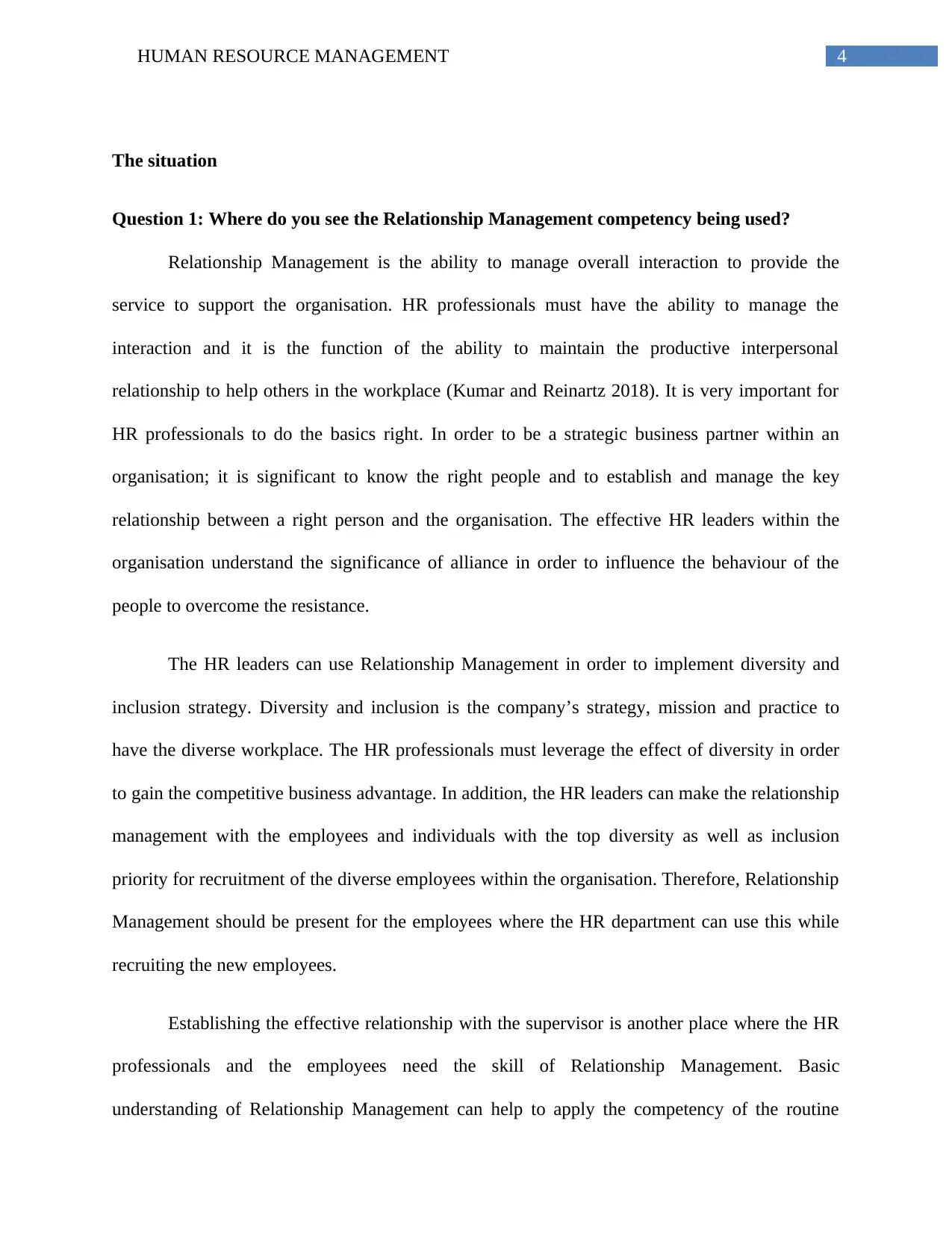
4HUMAN RESOURCE MANAGEMENT
The situation
Question 1: Where do you see the Relationship Management competency being used?
Relationship Management is the ability to manage overall interaction to provide the
service to support the organisation. HR professionals must have the ability to manage the
interaction and it is the function of the ability to maintain the productive interpersonal
relationship to help others in the workplace (Kumar and Reinartz 2018). It is very important for
HR professionals to do the basics right. In order to be a strategic business partner within an
organisation; it is significant to know the right people and to establish and manage the key
relationship between a right person and the organisation. The effective HR leaders within the
organisation understand the significance of alliance in order to influence the behaviour of the
people to overcome the resistance.
The HR leaders can use Relationship Management in order to implement diversity and
inclusion strategy. Diversity and inclusion is the company’s strategy, mission and practice to
have the diverse workplace. The HR professionals must leverage the effect of diversity in order
to gain the competitive business advantage. In addition, the HR leaders can make the relationship
management with the employees and individuals with the top diversity as well as inclusion
priority for recruitment of the diverse employees within the organisation. Therefore, Relationship
Management should be present for the employees where the HR department can use this while
recruiting the new employees.
Establishing the effective relationship with the supervisor is another place where the HR
professionals and the employees need the skill of Relationship Management. Basic
understanding of Relationship Management can help to apply the competency of the routine
The situation
Question 1: Where do you see the Relationship Management competency being used?
Relationship Management is the ability to manage overall interaction to provide the
service to support the organisation. HR professionals must have the ability to manage the
interaction and it is the function of the ability to maintain the productive interpersonal
relationship to help others in the workplace (Kumar and Reinartz 2018). It is very important for
HR professionals to do the basics right. In order to be a strategic business partner within an
organisation; it is significant to know the right people and to establish and manage the key
relationship between a right person and the organisation. The effective HR leaders within the
organisation understand the significance of alliance in order to influence the behaviour of the
people to overcome the resistance.
The HR leaders can use Relationship Management in order to implement diversity and
inclusion strategy. Diversity and inclusion is the company’s strategy, mission and practice to
have the diverse workplace. The HR professionals must leverage the effect of diversity in order
to gain the competitive business advantage. In addition, the HR leaders can make the relationship
management with the employees and individuals with the top diversity as well as inclusion
priority for recruitment of the diverse employees within the organisation. Therefore, Relationship
Management should be present for the employees where the HR department can use this while
recruiting the new employees.
Establishing the effective relationship with the supervisor is another place where the HR
professionals and the employees need the skill of Relationship Management. Basic
understanding of Relationship Management can help to apply the competency of the routine
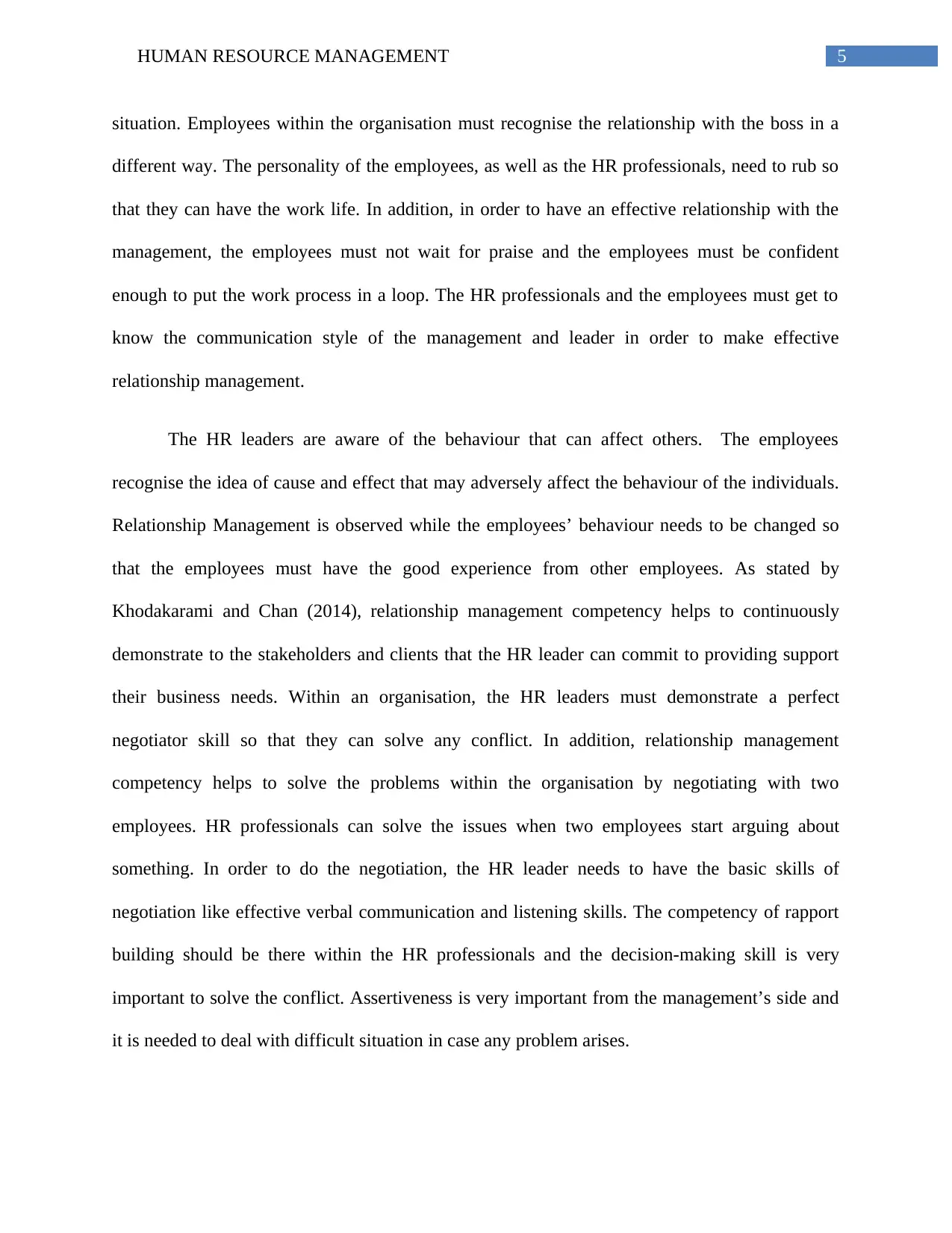
5HUMAN RESOURCE MANAGEMENT
situation. Employees within the organisation must recognise the relationship with the boss in a
different way. The personality of the employees, as well as the HR professionals, need to rub so
that they can have the work life. In addition, in order to have an effective relationship with the
management, the employees must not wait for praise and the employees must be confident
enough to put the work process in a loop. The HR professionals and the employees must get to
know the communication style of the management and leader in order to make effective
relationship management.
The HR leaders are aware of the behaviour that can affect others. The employees
recognise the idea of cause and effect that may adversely affect the behaviour of the individuals.
Relationship Management is observed while the employees’ behaviour needs to be changed so
that the employees must have the good experience from other employees. As stated by
Khodakarami and Chan (2014), relationship management competency helps to continuously
demonstrate to the stakeholders and clients that the HR leader can commit to providing support
their business needs. Within an organisation, the HR leaders must demonstrate a perfect
negotiator skill so that they can solve any conflict. In addition, relationship management
competency helps to solve the problems within the organisation by negotiating with two
employees. HR professionals can solve the issues when two employees start arguing about
something. In order to do the negotiation, the HR leader needs to have the basic skills of
negotiation like effective verbal communication and listening skills. The competency of rapport
building should be there within the HR professionals and the decision-making skill is very
important to solve the conflict. Assertiveness is very important from the management’s side and
it is needed to deal with difficult situation in case any problem arises.
situation. Employees within the organisation must recognise the relationship with the boss in a
different way. The personality of the employees, as well as the HR professionals, need to rub so
that they can have the work life. In addition, in order to have an effective relationship with the
management, the employees must not wait for praise and the employees must be confident
enough to put the work process in a loop. The HR professionals and the employees must get to
know the communication style of the management and leader in order to make effective
relationship management.
The HR leaders are aware of the behaviour that can affect others. The employees
recognise the idea of cause and effect that may adversely affect the behaviour of the individuals.
Relationship Management is observed while the employees’ behaviour needs to be changed so
that the employees must have the good experience from other employees. As stated by
Khodakarami and Chan (2014), relationship management competency helps to continuously
demonstrate to the stakeholders and clients that the HR leader can commit to providing support
their business needs. Within an organisation, the HR leaders must demonstrate a perfect
negotiator skill so that they can solve any conflict. In addition, relationship management
competency helps to solve the problems within the organisation by negotiating with two
employees. HR professionals can solve the issues when two employees start arguing about
something. In order to do the negotiation, the HR leader needs to have the basic skills of
negotiation like effective verbal communication and listening skills. The competency of rapport
building should be there within the HR professionals and the decision-making skill is very
important to solve the conflict. Assertiveness is very important from the management’s side and
it is needed to deal with difficult situation in case any problem arises.
⊘ This is a preview!⊘
Do you want full access?
Subscribe today to unlock all pages.

Trusted by 1+ million students worldwide
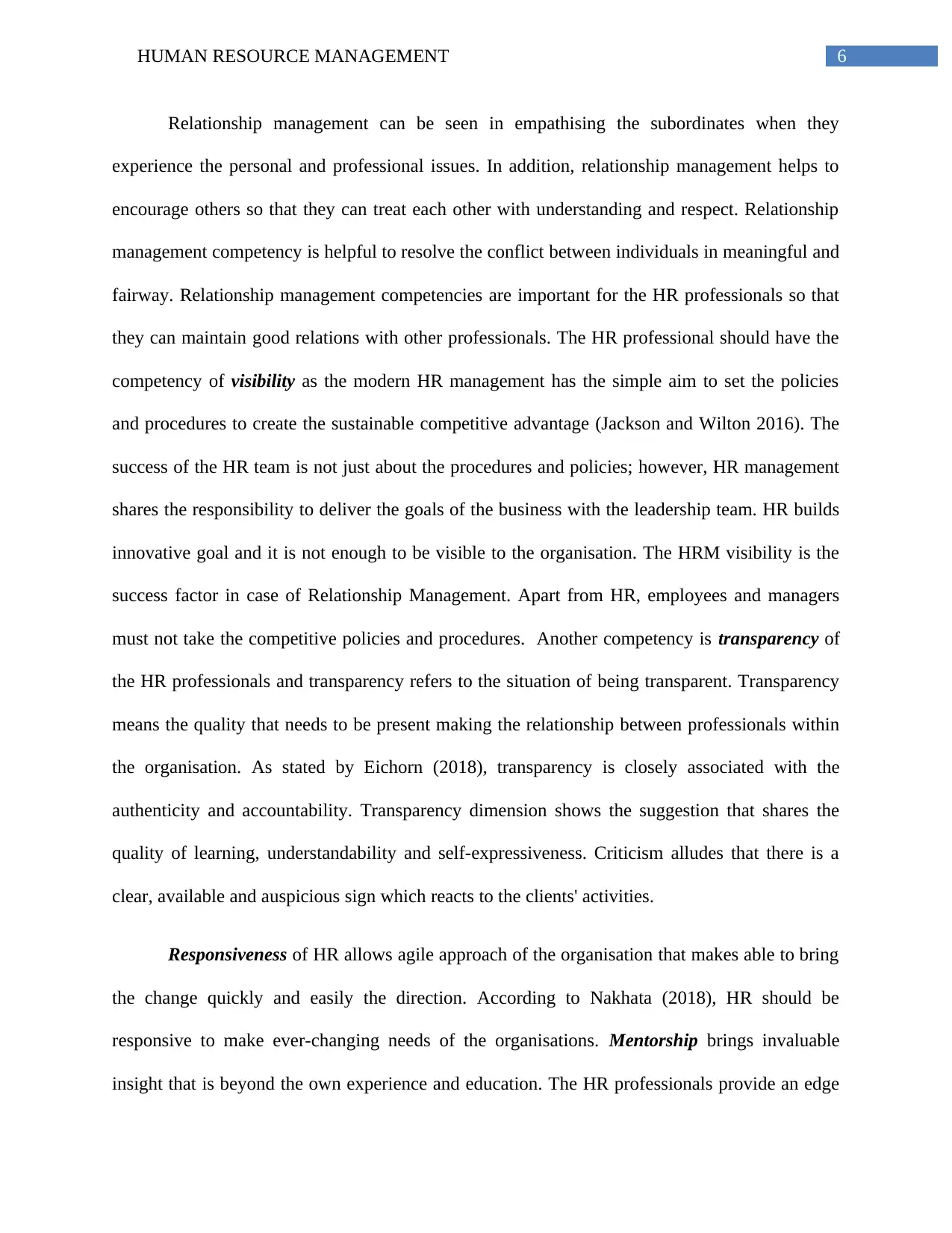
6HUMAN RESOURCE MANAGEMENT
Relationship management can be seen in empathising the subordinates when they
experience the personal and professional issues. In addition, relationship management helps to
encourage others so that they can treat each other with understanding and respect. Relationship
management competency is helpful to resolve the conflict between individuals in meaningful and
fairway. Relationship management competencies are important for the HR professionals so that
they can maintain good relations with other professionals. The HR professional should have the
competency of visibility as the modern HR management has the simple aim to set the policies
and procedures to create the sustainable competitive advantage (Jackson and Wilton 2016). The
success of the HR team is not just about the procedures and policies; however, HR management
shares the responsibility to deliver the goals of the business with the leadership team. HR builds
innovative goal and it is not enough to be visible to the organisation. The HRM visibility is the
success factor in case of Relationship Management. Apart from HR, employees and managers
must not take the competitive policies and procedures. Another competency is transparency of
the HR professionals and transparency refers to the situation of being transparent. Transparency
means the quality that needs to be present making the relationship between professionals within
the organisation. As stated by Eichorn (2018), transparency is closely associated with the
authenticity and accountability. Transparency dimension shows the suggestion that shares the
quality of learning, understandability and self-expressiveness. Criticism alludes that there is a
clear, available and auspicious sign which reacts to the clients' activities.
Responsiveness of HR allows agile approach of the organisation that makes able to bring
the change quickly and easily the direction. According to Nakhata (2018), HR should be
responsive to make ever-changing needs of the organisations. Mentorship brings invaluable
insight that is beyond the own experience and education. The HR professionals provide an edge
Relationship management can be seen in empathising the subordinates when they
experience the personal and professional issues. In addition, relationship management helps to
encourage others so that they can treat each other with understanding and respect. Relationship
management competency is helpful to resolve the conflict between individuals in meaningful and
fairway. Relationship management competencies are important for the HR professionals so that
they can maintain good relations with other professionals. The HR professional should have the
competency of visibility as the modern HR management has the simple aim to set the policies
and procedures to create the sustainable competitive advantage (Jackson and Wilton 2016). The
success of the HR team is not just about the procedures and policies; however, HR management
shares the responsibility to deliver the goals of the business with the leadership team. HR builds
innovative goal and it is not enough to be visible to the organisation. The HRM visibility is the
success factor in case of Relationship Management. Apart from HR, employees and managers
must not take the competitive policies and procedures. Another competency is transparency of
the HR professionals and transparency refers to the situation of being transparent. Transparency
means the quality that needs to be present making the relationship between professionals within
the organisation. As stated by Eichorn (2018), transparency is closely associated with the
authenticity and accountability. Transparency dimension shows the suggestion that shares the
quality of learning, understandability and self-expressiveness. Criticism alludes that there is a
clear, available and auspicious sign which reacts to the clients' activities.
Responsiveness of HR allows agile approach of the organisation that makes able to bring
the change quickly and easily the direction. According to Nakhata (2018), HR should be
responsive to make ever-changing needs of the organisations. Mentorship brings invaluable
insight that is beyond the own experience and education. The HR professionals provide an edge
Paraphrase This Document
Need a fresh take? Get an instant paraphrase of this document with our AI Paraphraser
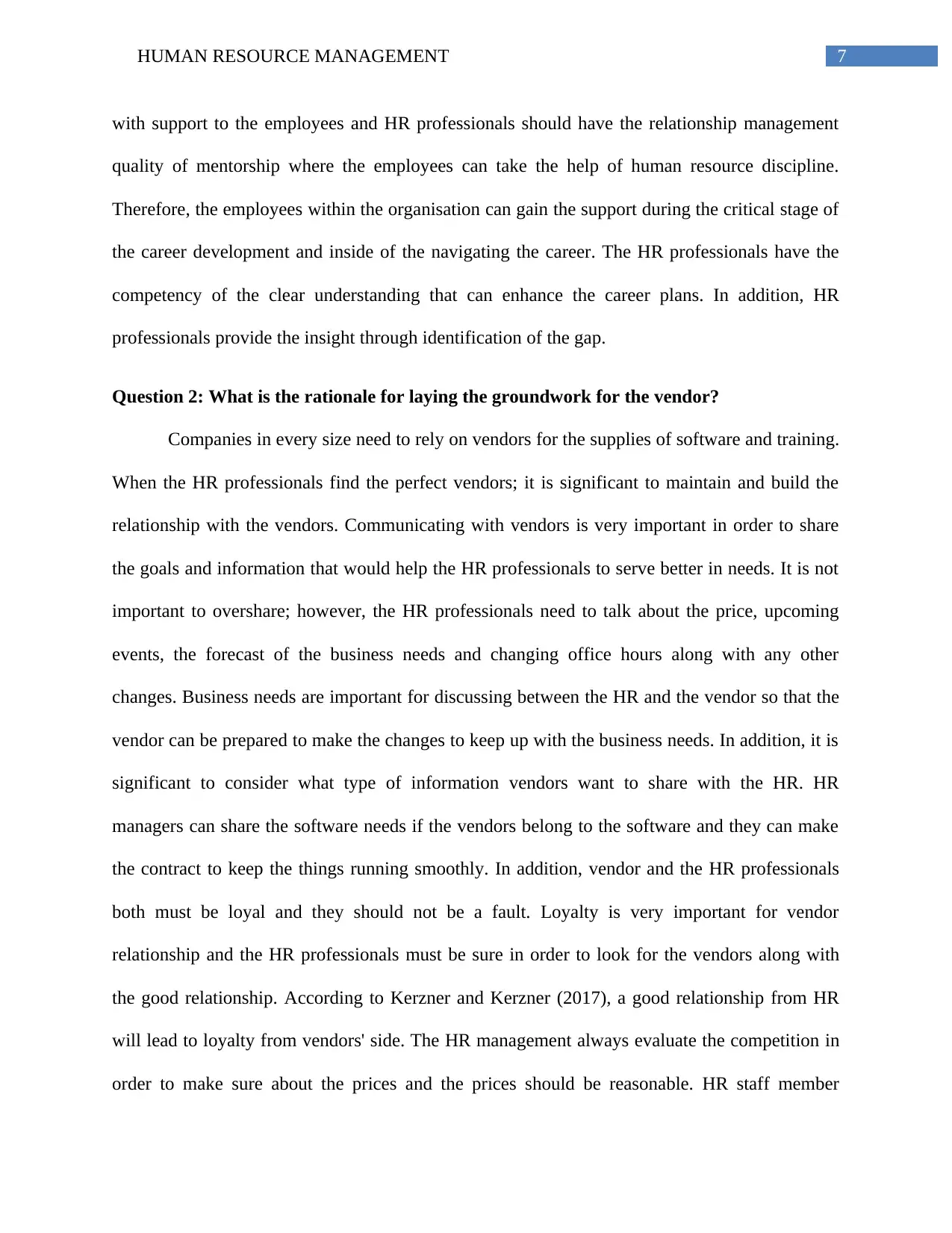
7HUMAN RESOURCE MANAGEMENT
with support to the employees and HR professionals should have the relationship management
quality of mentorship where the employees can take the help of human resource discipline.
Therefore, the employees within the organisation can gain the support during the critical stage of
the career development and inside of the navigating the career. The HR professionals have the
competency of the clear understanding that can enhance the career plans. In addition, HR
professionals provide the insight through identification of the gap.
Question 2: What is the rationale for laying the groundwork for the vendor?
Companies in every size need to rely on vendors for the supplies of software and training.
When the HR professionals find the perfect vendors; it is significant to maintain and build the
relationship with the vendors. Communicating with vendors is very important in order to share
the goals and information that would help the HR professionals to serve better in needs. It is not
important to overshare; however, the HR professionals need to talk about the price, upcoming
events, the forecast of the business needs and changing office hours along with any other
changes. Business needs are important for discussing between the HR and the vendor so that the
vendor can be prepared to make the changes to keep up with the business needs. In addition, it is
significant to consider what type of information vendors want to share with the HR. HR
managers can share the software needs if the vendors belong to the software and they can make
the contract to keep the things running smoothly. In addition, vendor and the HR professionals
both must be loyal and they should not be a fault. Loyalty is very important for vendor
relationship and the HR professionals must be sure in order to look for the vendors along with
the good relationship. According to Kerzner and Kerzner (2017), a good relationship from HR
will lead to loyalty from vendors' side. The HR management always evaluate the competition in
order to make sure about the prices and the prices should be reasonable. HR staff member
with support to the employees and HR professionals should have the relationship management
quality of mentorship where the employees can take the help of human resource discipline.
Therefore, the employees within the organisation can gain the support during the critical stage of
the career development and inside of the navigating the career. The HR professionals have the
competency of the clear understanding that can enhance the career plans. In addition, HR
professionals provide the insight through identification of the gap.
Question 2: What is the rationale for laying the groundwork for the vendor?
Companies in every size need to rely on vendors for the supplies of software and training.
When the HR professionals find the perfect vendors; it is significant to maintain and build the
relationship with the vendors. Communicating with vendors is very important in order to share
the goals and information that would help the HR professionals to serve better in needs. It is not
important to overshare; however, the HR professionals need to talk about the price, upcoming
events, the forecast of the business needs and changing office hours along with any other
changes. Business needs are important for discussing between the HR and the vendor so that the
vendor can be prepared to make the changes to keep up with the business needs. In addition, it is
significant to consider what type of information vendors want to share with the HR. HR
managers can share the software needs if the vendors belong to the software and they can make
the contract to keep the things running smoothly. In addition, vendor and the HR professionals
both must be loyal and they should not be a fault. Loyalty is very important for vendor
relationship and the HR professionals must be sure in order to look for the vendors along with
the good relationship. According to Kerzner and Kerzner (2017), a good relationship from HR
will lead to loyalty from vendors' side. The HR management always evaluate the competition in
order to make sure about the prices and the prices should be reasonable. HR staff member
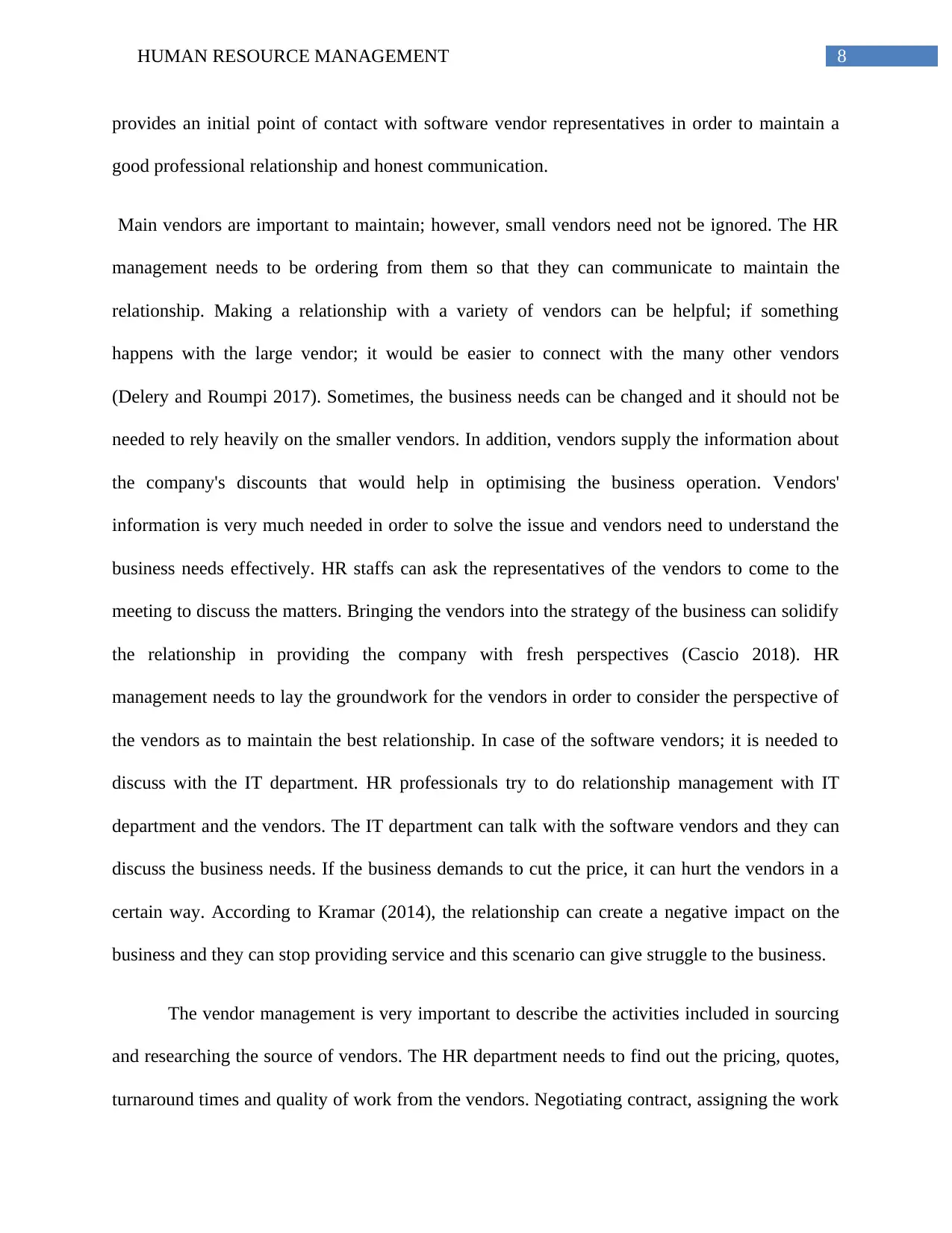
8HUMAN RESOURCE MANAGEMENT
provides an initial point of contact with software vendor representatives in order to maintain a
good professional relationship and honest communication.
Main vendors are important to maintain; however, small vendors need not be ignored. The HR
management needs to be ordering from them so that they can communicate to maintain the
relationship. Making a relationship with a variety of vendors can be helpful; if something
happens with the large vendor; it would be easier to connect with the many other vendors
(Delery and Roumpi 2017). Sometimes, the business needs can be changed and it should not be
needed to rely heavily on the smaller vendors. In addition, vendors supply the information about
the company's discounts that would help in optimising the business operation. Vendors'
information is very much needed in order to solve the issue and vendors need to understand the
business needs effectively. HR staffs can ask the representatives of the vendors to come to the
meeting to discuss the matters. Bringing the vendors into the strategy of the business can solidify
the relationship in providing the company with fresh perspectives (Cascio 2018). HR
management needs to lay the groundwork for the vendors in order to consider the perspective of
the vendors as to maintain the best relationship. In case of the software vendors; it is needed to
discuss with the IT department. HR professionals try to do relationship management with IT
department and the vendors. The IT department can talk with the software vendors and they can
discuss the business needs. If the business demands to cut the price, it can hurt the vendors in a
certain way. According to Kramar (2014), the relationship can create a negative impact on the
business and they can stop providing service and this scenario can give struggle to the business.
The vendor management is very important to describe the activities included in sourcing
and researching the source of vendors. The HR department needs to find out the pricing, quotes,
turnaround times and quality of work from the vendors. Negotiating contract, assigning the work
provides an initial point of contact with software vendor representatives in order to maintain a
good professional relationship and honest communication.
Main vendors are important to maintain; however, small vendors need not be ignored. The HR
management needs to be ordering from them so that they can communicate to maintain the
relationship. Making a relationship with a variety of vendors can be helpful; if something
happens with the large vendor; it would be easier to connect with the many other vendors
(Delery and Roumpi 2017). Sometimes, the business needs can be changed and it should not be
needed to rely heavily on the smaller vendors. In addition, vendors supply the information about
the company's discounts that would help in optimising the business operation. Vendors'
information is very much needed in order to solve the issue and vendors need to understand the
business needs effectively. HR staffs can ask the representatives of the vendors to come to the
meeting to discuss the matters. Bringing the vendors into the strategy of the business can solidify
the relationship in providing the company with fresh perspectives (Cascio 2018). HR
management needs to lay the groundwork for the vendors in order to consider the perspective of
the vendors as to maintain the best relationship. In case of the software vendors; it is needed to
discuss with the IT department. HR professionals try to do relationship management with IT
department and the vendors. The IT department can talk with the software vendors and they can
discuss the business needs. If the business demands to cut the price, it can hurt the vendors in a
certain way. According to Kramar (2014), the relationship can create a negative impact on the
business and they can stop providing service and this scenario can give struggle to the business.
The vendor management is very important to describe the activities included in sourcing
and researching the source of vendors. The HR department needs to find out the pricing, quotes,
turnaround times and quality of work from the vendors. Negotiating contract, assigning the work
⊘ This is a preview!⊘
Do you want full access?
Subscribe today to unlock all pages.

Trusted by 1+ million students worldwide
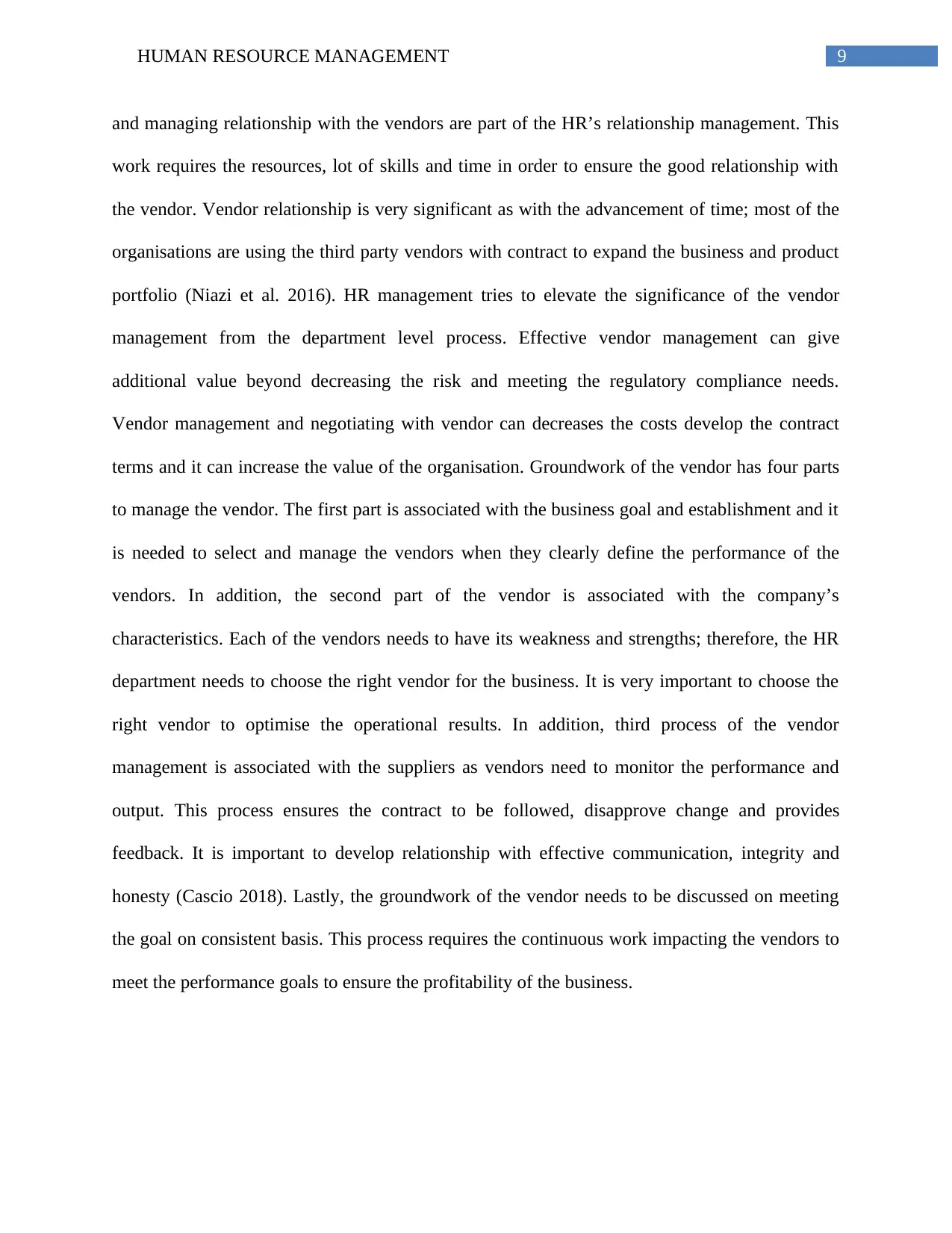
9HUMAN RESOURCE MANAGEMENT
and managing relationship with the vendors are part of the HR’s relationship management. This
work requires the resources, lot of skills and time in order to ensure the good relationship with
the vendor. Vendor relationship is very significant as with the advancement of time; most of the
organisations are using the third party vendors with contract to expand the business and product
portfolio (Niazi et al. 2016). HR management tries to elevate the significance of the vendor
management from the department level process. Effective vendor management can give
additional value beyond decreasing the risk and meeting the regulatory compliance needs.
Vendor management and negotiating with vendor can decreases the costs develop the contract
terms and it can increase the value of the organisation. Groundwork of the vendor has four parts
to manage the vendor. The first part is associated with the business goal and establishment and it
is needed to select and manage the vendors when they clearly define the performance of the
vendors. In addition, the second part of the vendor is associated with the company’s
characteristics. Each of the vendors needs to have its weakness and strengths; therefore, the HR
department needs to choose the right vendor for the business. It is very important to choose the
right vendor to optimise the operational results. In addition, third process of the vendor
management is associated with the suppliers as vendors need to monitor the performance and
output. This process ensures the contract to be followed, disapprove change and provides
feedback. It is important to develop relationship with effective communication, integrity and
honesty (Cascio 2018). Lastly, the groundwork of the vendor needs to be discussed on meeting
the goal on consistent basis. This process requires the continuous work impacting the vendors to
meet the performance goals to ensure the profitability of the business.
and managing relationship with the vendors are part of the HR’s relationship management. This
work requires the resources, lot of skills and time in order to ensure the good relationship with
the vendor. Vendor relationship is very significant as with the advancement of time; most of the
organisations are using the third party vendors with contract to expand the business and product
portfolio (Niazi et al. 2016). HR management tries to elevate the significance of the vendor
management from the department level process. Effective vendor management can give
additional value beyond decreasing the risk and meeting the regulatory compliance needs.
Vendor management and negotiating with vendor can decreases the costs develop the contract
terms and it can increase the value of the organisation. Groundwork of the vendor has four parts
to manage the vendor. The first part is associated with the business goal and establishment and it
is needed to select and manage the vendors when they clearly define the performance of the
vendors. In addition, the second part of the vendor is associated with the company’s
characteristics. Each of the vendors needs to have its weakness and strengths; therefore, the HR
department needs to choose the right vendor for the business. It is very important to choose the
right vendor to optimise the operational results. In addition, third process of the vendor
management is associated with the suppliers as vendors need to monitor the performance and
output. This process ensures the contract to be followed, disapprove change and provides
feedback. It is important to develop relationship with effective communication, integrity and
honesty (Cascio 2018). Lastly, the groundwork of the vendor needs to be discussed on meeting
the goal on consistent basis. This process requires the continuous work impacting the vendors to
meet the performance goals to ensure the profitability of the business.
Paraphrase This Document
Need a fresh take? Get an instant paraphrase of this document with our AI Paraphraser
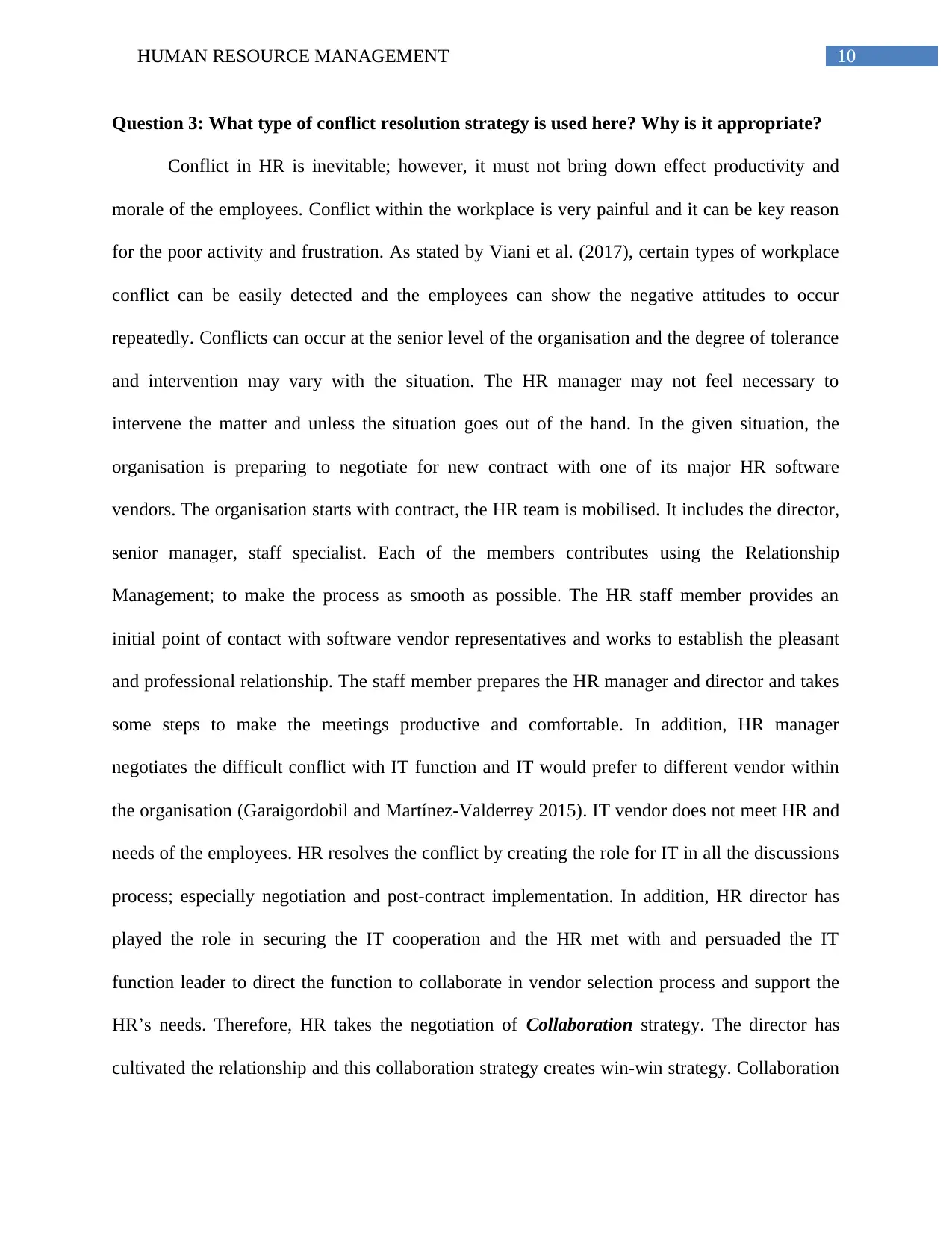
10HUMAN RESOURCE MANAGEMENT
Question 3: What type of conflict resolution strategy is used here? Why is it appropriate?
Conflict in HR is inevitable; however, it must not bring down effect productivity and
morale of the employees. Conflict within the workplace is very painful and it can be key reason
for the poor activity and frustration. As stated by Viani et al. (2017), certain types of workplace
conflict can be easily detected and the employees can show the negative attitudes to occur
repeatedly. Conflicts can occur at the senior level of the organisation and the degree of tolerance
and intervention may vary with the situation. The HR manager may not feel necessary to
intervene the matter and unless the situation goes out of the hand. In the given situation, the
organisation is preparing to negotiate for new contract with one of its major HR software
vendors. The organisation starts with contract, the HR team is mobilised. It includes the director,
senior manager, staff specialist. Each of the members contributes using the Relationship
Management; to make the process as smooth as possible. The HR staff member provides an
initial point of contact with software vendor representatives and works to establish the pleasant
and professional relationship. The staff member prepares the HR manager and director and takes
some steps to make the meetings productive and comfortable. In addition, HR manager
negotiates the difficult conflict with IT function and IT would prefer to different vendor within
the organisation (Garaigordobil and Martínez-Valderrey 2015). IT vendor does not meet HR and
needs of the employees. HR resolves the conflict by creating the role for IT in all the discussions
process; especially negotiation and post-contract implementation. In addition, HR director has
played the role in securing the IT cooperation and the HR met with and persuaded the IT
function leader to direct the function to collaborate in vendor selection process and support the
HR’s needs. Therefore, HR takes the negotiation of Collaboration strategy. The director has
cultivated the relationship and this collaboration strategy creates win-win strategy. Collaboration
Question 3: What type of conflict resolution strategy is used here? Why is it appropriate?
Conflict in HR is inevitable; however, it must not bring down effect productivity and
morale of the employees. Conflict within the workplace is very painful and it can be key reason
for the poor activity and frustration. As stated by Viani et al. (2017), certain types of workplace
conflict can be easily detected and the employees can show the negative attitudes to occur
repeatedly. Conflicts can occur at the senior level of the organisation and the degree of tolerance
and intervention may vary with the situation. The HR manager may not feel necessary to
intervene the matter and unless the situation goes out of the hand. In the given situation, the
organisation is preparing to negotiate for new contract with one of its major HR software
vendors. The organisation starts with contract, the HR team is mobilised. It includes the director,
senior manager, staff specialist. Each of the members contributes using the Relationship
Management; to make the process as smooth as possible. The HR staff member provides an
initial point of contact with software vendor representatives and works to establish the pleasant
and professional relationship. The staff member prepares the HR manager and director and takes
some steps to make the meetings productive and comfortable. In addition, HR manager
negotiates the difficult conflict with IT function and IT would prefer to different vendor within
the organisation (Garaigordobil and Martínez-Valderrey 2015). IT vendor does not meet HR and
needs of the employees. HR resolves the conflict by creating the role for IT in all the discussions
process; especially negotiation and post-contract implementation. In addition, HR director has
played the role in securing the IT cooperation and the HR met with and persuaded the IT
function leader to direct the function to collaborate in vendor selection process and support the
HR’s needs. Therefore, HR takes the negotiation of Collaboration strategy. The director has
cultivated the relationship and this collaboration strategy creates win-win strategy. Collaboration
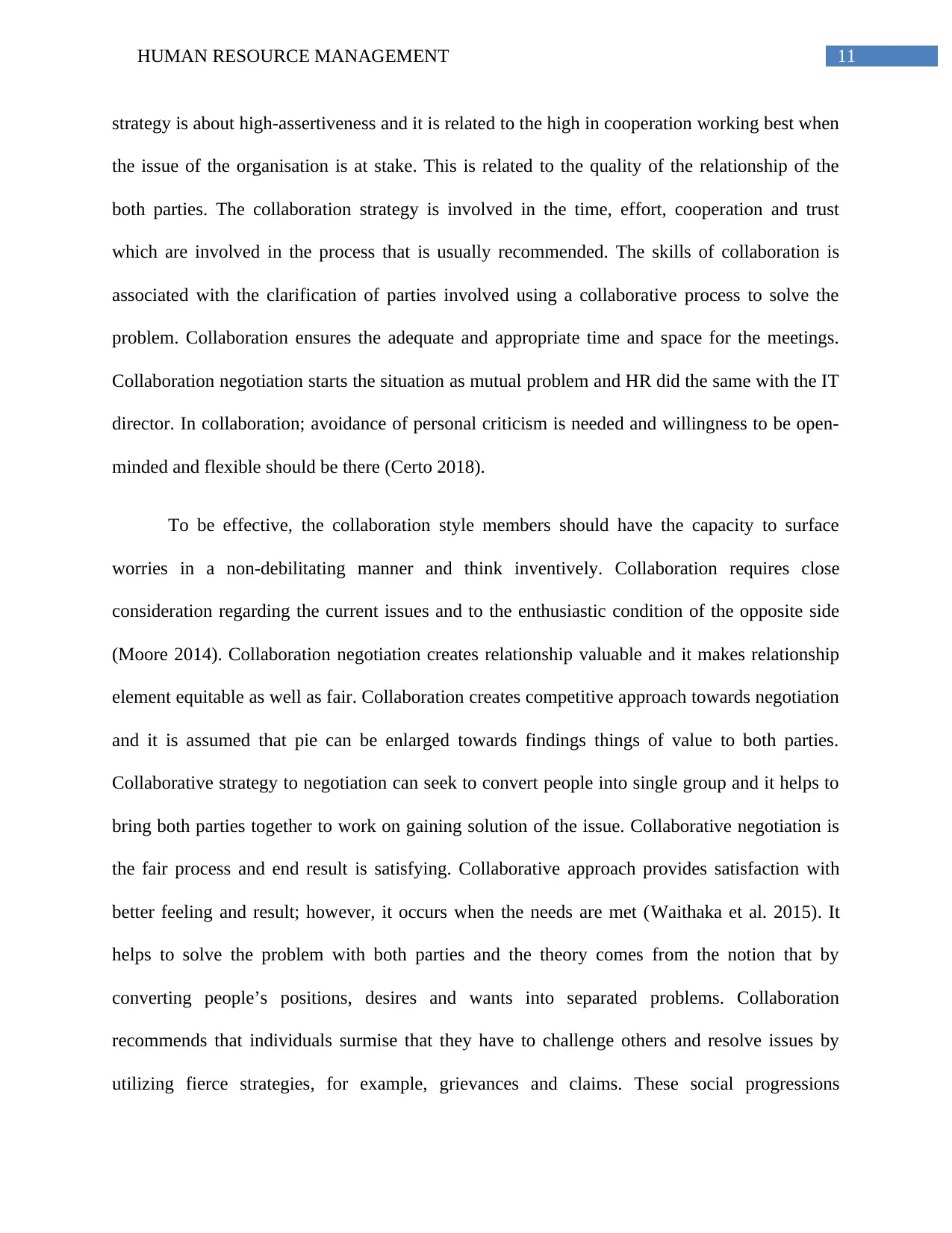
11HUMAN RESOURCE MANAGEMENT
strategy is about high-assertiveness and it is related to the high in cooperation working best when
the issue of the organisation is at stake. This is related to the quality of the relationship of the
both parties. The collaboration strategy is involved in the time, effort, cooperation and trust
which are involved in the process that is usually recommended. The skills of collaboration is
associated with the clarification of parties involved using a collaborative process to solve the
problem. Collaboration ensures the adequate and appropriate time and space for the meetings.
Collaboration negotiation starts the situation as mutual problem and HR did the same with the IT
director. In collaboration; avoidance of personal criticism is needed and willingness to be open-
minded and flexible should be there (Certo 2018).
To be effective, the collaboration style members should have the capacity to surface
worries in a non-debilitating manner and think inventively. Collaboration requires close
consideration regarding the current issues and to the enthusiastic condition of the opposite side
(Moore 2014). Collaboration negotiation creates relationship valuable and it makes relationship
element equitable as well as fair. Collaboration creates competitive approach towards negotiation
and it is assumed that pie can be enlarged towards findings things of value to both parties.
Collaborative strategy to negotiation can seek to convert people into single group and it helps to
bring both parties together to work on gaining solution of the issue. Collaborative negotiation is
the fair process and end result is satisfying. Collaborative approach provides satisfaction with
better feeling and result; however, it occurs when the needs are met (Waithaka et al. 2015). It
helps to solve the problem with both parties and the theory comes from the notion that by
converting people’s positions, desires and wants into separated problems. Collaboration
recommends that individuals surmise that they have to challenge others and resolve issues by
utilizing fierce strategies, for example, grievances and claims. These social progressions
strategy is about high-assertiveness and it is related to the high in cooperation working best when
the issue of the organisation is at stake. This is related to the quality of the relationship of the
both parties. The collaboration strategy is involved in the time, effort, cooperation and trust
which are involved in the process that is usually recommended. The skills of collaboration is
associated with the clarification of parties involved using a collaborative process to solve the
problem. Collaboration ensures the adequate and appropriate time and space for the meetings.
Collaboration negotiation starts the situation as mutual problem and HR did the same with the IT
director. In collaboration; avoidance of personal criticism is needed and willingness to be open-
minded and flexible should be there (Certo 2018).
To be effective, the collaboration style members should have the capacity to surface
worries in a non-debilitating manner and think inventively. Collaboration requires close
consideration regarding the current issues and to the enthusiastic condition of the opposite side
(Moore 2014). Collaboration negotiation creates relationship valuable and it makes relationship
element equitable as well as fair. Collaboration creates competitive approach towards negotiation
and it is assumed that pie can be enlarged towards findings things of value to both parties.
Collaborative strategy to negotiation can seek to convert people into single group and it helps to
bring both parties together to work on gaining solution of the issue. Collaborative negotiation is
the fair process and end result is satisfying. Collaborative approach provides satisfaction with
better feeling and result; however, it occurs when the needs are met (Waithaka et al. 2015). It
helps to solve the problem with both parties and the theory comes from the notion that by
converting people’s positions, desires and wants into separated problems. Collaboration
recommends that individuals surmise that they have to challenge others and resolve issues by
utilizing fierce strategies, for example, grievances and claims. These social progressions
⊘ This is a preview!⊘
Do you want full access?
Subscribe today to unlock all pages.

Trusted by 1+ million students worldwide
1 out of 38
Related Documents
Your All-in-One AI-Powered Toolkit for Academic Success.
+13062052269
info@desklib.com
Available 24*7 on WhatsApp / Email
![[object Object]](/_next/static/media/star-bottom.7253800d.svg)
Unlock your academic potential
Copyright © 2020–2025 A2Z Services. All Rights Reserved. Developed and managed by ZUCOL.




